HTC Windows Phone 8X -- Purple madness [Review]
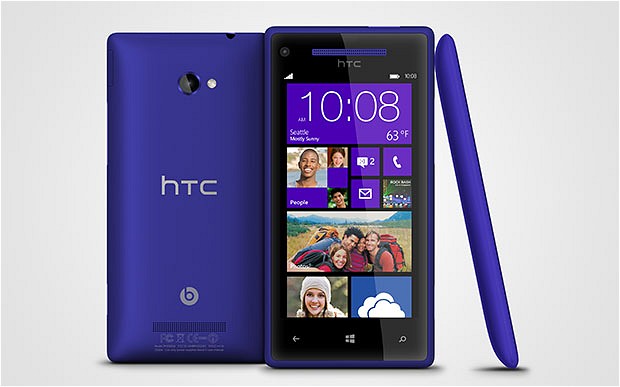
The HTC Windows Phone 8X is a smartphone that you will either love or not want
to touch even with a 10 foot pole. Part of the arguments for and against it stem
from the operating system of choice, Microsoft's latest (and greatest) Windows
Phone iteration. Sure, the device has good build quality and the software is
fluid and responsive, but the app selection is currently lacking compared to
rivals like Android and iOS. So where does one draw the line between success and
failure?
I've been using the Windows Phone 8X for almost two weeks and the early
impressions are still on the positive side. In my initial review I touched on a
number of points that I found revealing for my brief time with it, but the real
test is how the Windows Phone 8X fares over a longer period of time. My main and
initial gripes concern the limited app selection and general usability issues of
Windows Phone 8 when coming from the stock flavor of Android 4.2 Jelly Bean. The
real question is this: Is it good enough?
The Specs
The HTC Windows Phone 8X features a 4.3-inch Super LCD 2 display with a
resolution of 1280 by 720. The handset is powered by a 1.5GHz dual-core Qualcomm
Snapdragon S4 processor, 1GB of RAM and an 1,800mAh battery. There is 16GB of
non-expandable internal storage onboard, or 8GB of internal storage depending on
the carrier variant. My Windows Phone 8X is the California Blue international
variant, and comes with the former option.
The Windows Phone 8X sports HSPA+ cellular connectivity (LTE is available
depending on the market); Wi-Fi 802.11 a/b/g/n; Bluetooth 3.1; NFC (Near Field
Communication); GPS with Glonass support as well as the common plethora of
sensors. The device ships with an 8MP back-facing camera and a 2.1MP shooter on
the front, both capable of 1080p video recording. Other specs include Beats
Audio support and a 3.5mm headphone jack.
The Windows Phone 8X measures 132.35 x 66.2 x 10.12 mm. Weight comes in at 130
grams.
Great Social Integration, but not Perfect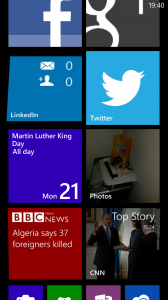
I'll kick off with the social element. Windows Phone 8 places social (or human
if you will) interaction at the forefront, be it through the Me tile and People
app pinned on the homescreen or through the social network integration. Users
can post straight to Facebook, LinkedIn and Twitter right after pressing their
own live tile, view social notifications and check on what other connected folks
are doing. Social, social, social. But not that social.
As you may expect the main gripe with Windows Phone 8 in terms of social
integration is Google+, or the lack thereof. For me that's a deal breaker when
it comes to any mobile device, more so with a smartphone as it's the only one
that I carry around with me. That would be relatively fine had Google bothered
to release an official app but, sadly, the only ones available are third party
offerings that display a mobile view. Not modern, not modern at all.
It's one of the worst parts in dealing with Windows Phone 8 on a day-to-day
basis, and really puts a dent in enjoying the operating system. That's a shame
as Microsoft managed to deliver an impressive package in this regard -- the
unified social notifications in the Me tile is great, the People app is really
useful in finding out what your buddies are doing, and the Rooms and Groups
features for private chats and sharing are nice as well.
Users can also expect an official Foursquare app and third party Pinterest and
Reddit clients, among others. For those roaming around interwebs forums, Board
Express is a nice and free Tapatalk alternative, although like most third party
apps it's supported by ads. So far, I have found a working replacement for
almost every social app that I use on Android and iOS.
Let's Talk Mail
What's a smartphone operating system without a competent email client?
Thankfully Windows Phone 8 includes support for Gmail, Hotmail, Outlook.com,
Yahoo! Mail, generic POP and IMAP accounts, as well as Exchange ActiveSync
support, among other types of supported accounts such as Facebook, LinkedIn,
Twitter or Sina Weibo.
I will not bore you with generic details, but suffice to say that it works as
expected -- you get emails, they show up. There are some issues though which I
struggle with on a day to day basis, ones which a Gmail user on Android will
undoubtedly find annoying to deal with (and likely others as well). As a point
of reference I have set up Outlook using the Microsoft-preferred method and
Gmail as an Exchange ActiveSync account in order to take advantage of push email
as well as calendar and contacts synchronization.
With both types of accounts I have noticed that marking an email as read does
not necessarily mean that it will be listed as read when checking the web app.
This is a nuisance that reminds me of just how trouble-free the Gmail and Email
apps on Android really are. Furthermore, after applying a batch action the
previously selected emails will be unticked and you have to start over ticking
them again as to perform another batch action.
The third issue comes from using Gmail. Unlike with the Android counterpart, on
Windows Phone 8 there is no Archive button as to immediately move emails
straight to All Mail. I have to do that by hand, which is time-consuming and
bothersome when dealing with a ton of emails each day. The fourth issue, and the
most frustrating, is yet again with Gmail -- emails cannot be sent using aliases
from a single account. I have to add each and every single one in order to get
that functionality.
Great Phone
The Windows Phone 8X (and Windows Phone 8 by implication) is great at making
calls and sending texts. The sound through the headpiece is loud and clear,
sometimes too loud with the
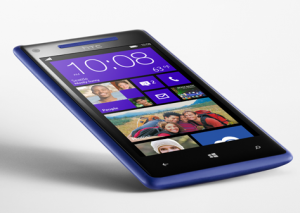
volume raised all the way up. I have noticed a few dropped calls, although I
cannot really fault the device for any of those since although I had a decent
signal the person at the other end of the line did not.
This is not a Windows Phone 8 fault per se, but I'd like to have a dedicated
contact list just for making calls. By default, and this applies to Android as
well, the operating system uses a unified contacts list for all corresponding
apps, which is overkill when looking up someone to call. I doubt this will be
implemented, but it would be nice to have for someone like me that makes plenty
of calls each day.
In the texting department, I do really have to commend Microsoft for the
extensive dictionary selection. Unlike Google, which doesn't bother with stock
Jelly Bean, the Redmond, Wash.-based software corporation admits to the
existence of more than a couple of languages. I count more than 60 dictionaries
for a variety of languages, which really comes in handy when writing texts (but
applies to other areas as well).
The keyboard itself is quite nice to use, without any of the swiping gimmickry,
and provides decent word predictions. The keys are rather tall and narrow, but
even with my big thumbs I can write without making too many mistakes while
typing. It's worth noting that the space bar, at least on the Windows Phone 8X,
is quite narrow and too close to the "," sign, making accidental presses a
common occurrence.
Maps
Straight off the bat I do have to point out that I do not find much use for a
maps app. Most of the time I know where I am and how to get to where I want,
although I can understand why others may feel the need for navigation and
similar features. Where I live functionality is rather limited when it comes to
discovering nearby shops, restaurants and movie theatres to name a few. They're
there but don't show up on maps, hence my rare, online and offline, use of Maps.
The Maps app on Windows Phone 8 implements Bing Maps as one might expect, but
with some features supported by Nokia, and as far as I can tell only works in
portrait mode. That's a real bummer, and something to consider when using the
Windows Phone 8X with car mounts. I have no doubt that the recently introduced
Nokia Drive+ is a more suited alternative for navigation, but since it only
works with US, UK and Canadian SIM cards it's pointless for billions of people
on the globe. Whoever took charge and decided to offer Drive+ in just three
locations is clearly short-sighted, to put it kindly.
Within the Maps app users can also find a navigation feature, dubbed
"directions" which works as expected at a first glance, but again only in
portrait mode. There is also an option to display traffic, view favorite
locations and display an aerial view. By comparison, and I have only tested this
in my location, Google Maps, through the gMaps app, displays more detailed maps
and allows to zoom in more compared to Windows Phone 8's Maps app.
That said, users can download maps of entire countries and update them if
needed. As a point of reference the entire map of the United States of America
take up in excess of 2,556MB, with states like California and Delaware needing
208MB and 40MB, respectively.
Through the Maps app Windows Phone 8 users can also use the Scout feature, which
displays nearby "eat+drink", "see+do", "shop" and "for you" places on the map.
It's a similar feature to Google Now for instance, and I can only assume that it
works as expected for other regions other than mine. Again, I appear to live in
the desert or a remotely isolated area with Internet connectivity.
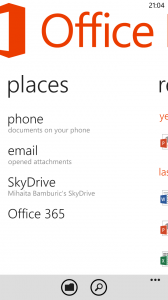
Office, Baby!
Call me an Office fan, I really don't mind. Although it does not live up to the
features of its desktop counterpart, the Office app on Windows Phone is a
welcome addition. It comes with Office 365 integration, can add SharePoint
locations, integrates with SkyDrive (which as a SkyDrive user I can certainly
appreciate), handles opened email attachments, and can also open and edit
locally stored documents.
I have covered the important details in the "Microsoft details Office on Windows
Phone 8" article but suffice to say that it works well, even on the 4.3-inch
display of the Windows Phone 8X. I mostly like the Excel and Word editing
features, which come in handy while on the go and ensure compatibility with
every modern office suite.
Undoubtedly, Office on Windows Phone 8 is one of the most important features of
the smartphone operating system. It works well for editing and viewing large
documents and spreadsheets (from a physical dimensions point of view) as well as
presentations and neatly integrates with other Microsoft services. I do have to
mention that the Samsung ATIV S or even the Nokia Lumia 920 might be better
suited for Office use, due to larger displays, compared to the Windows Phone 8X.
The App Store Conundrum
One of the first issues that I have to overcome in order to use the Windows
Phone 8X is the lack of official apps. Mostly everything that is Google-related
comes from third party developers,
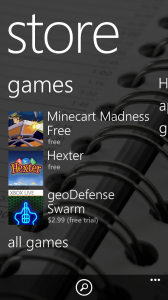
except a frankly pointless Google Search app from the Mountain View,
Calif.-based corporation, and a YouTube app made by Microsoft which displays a
mobile view of the popular video sharing website.
That said, there are working third party alternatives to Google+, Google Docs,
Google Drive, Google Maps, Google Play Music, Google Reader, Google Talk, Google
Voice, Picasa and YouTube. I've used a bunch of them, and while they may not
come from the search giant, each of the ones I’ve tried so far works as
intended. Keep that in mind if you're a Google user planning to buy a Windows
Phone 8 device soon and are afraid of leaving the comfort of Android or iOS.
There are plenty of official apps available ranging from Kindle and Amazon
Mobile, Bank of America, Box, eBay, Endomondo Sports Tracker, Evernote,
Fandango, Flixster, Glympse, Groupon, IMDb, Last.fm, Newegg, Nike+ Kinect
Training, OpenTable, PayPal, Shazam, SoundHound, Speedtest.net, TopGear News
(for much needed car news), TuneIn Radio, Vevo, Vimeo to The Weather Channel,
for instance.
There are third party Instagram clients, however neither is a replacement for
the official Instagram app which must come to Windows Phone as soon as possible.
Same goes for Google+. There are millions of people who rely on such apps on
their smartphones, so why not cater to that significant audience? Microsoft made
the official Facebook app, so why not do the same with Instagram? I'm sure
Facebook wouldn't mind.
Generally speaking I have found that if there is no official corresponding
Windows Phone 8 app, a suitable third party alternative can be installed
instead. That's not good enough though.
The Bummers
Moving on from the software onto the hardware and I do have to point a couple of
weaker traits, which affect either Windows Phone 8 or the Windows Phone 8X, or
both.
Seeing as my new smartphone has NFC I decided to give it a go and pair it with
my Google Galaxy Nexus. So I touch their back covers one to another (in an
appropriate manner that is) and wait for something to happen. Guess what? It
doesn't work, as the Windows Phone 8X and the Galaxy Nexus cannot pair, with the
latter requesting Android Beam to send files to the former (although I did get a
link to Google Play on the Windows Phone 8X). Oh, the joy of having NFC and be
unable to use it between different phones. This is an issue that plagues many
devices on major platforms.
The Windows Phone 8X features an LED indicator, but it only lights up to display
charging status. It's green when the battery is completely charged and red while
it's charging and that's it. Coming from the Galaxy Nexus I expected HTC's
device to feature a more usable LED indicator which lights up for missed calls,
new emails, Facebook notifications and such, but sadly it does not. I hope that
this feature will come with a future software upgrade, as it's disappointing to
let it go to waste.
One thing which I am not used to is the inconsistent implementation of the
disappearing status bar throughout apps. By default Windows Phone 8 only shows
the time within the status bar and in order to display the carrier network or
Wi-Fi signal strength one has to swipe down from the top of the screen. It's not
a bad implementation as it cleans up the look, but the gesture has no effect
within certain apps. FeedWorm is a good example where the app is not maximized
and there is a black bar on top which fails to display the status indicators
after swiping down.
The Camera
The Windows Phone 8X features an 8MP back-facing camera with an F2.0 aperture,
28mm lens, LED flash and a BSI sensor for low-light use. That suggests that it's
capable of capturing
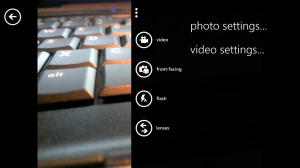
some great pics in poorly lit conditions, but sadly it is unable to deliver
spectacular results. I often notice that flash is not always needed even though
it's used and that color reproduction is not entirely accurate.
Colors tend to have a blueish tint when the flash is used and noise is present
from up close (without zoom) in low-lighting conditions, whereas in well-lit
scenarios the camera on the Windows Phone 8X shoots fairly decent pictures,
which are better than the ones produced by the Galaxy Nexus. The latter is not
exactly a professional shooter in disguise, but it's adequate for brief use.
That said, I have not noticed a single scenario where the Windows Phone 8X can
shoot pictures with accurate color reproduction. I am much more impressed by the
video camera, with manages to shoot decent videos with flash as well as without
it, although it could use better autofocus when pointing it around in different
directions. By contrast the front-facing camera is rather poor, which is to be
expected considering that it's just a 2.1MP unit.
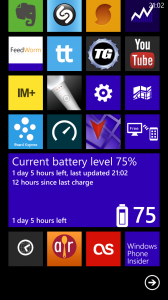 Battery
Life
Battery
Life
Battery life is difficult to quantify as usage scenarios differ from one person
to another. I use my phone most when I'm heading out and then I mostly check
email and browse the web, among other things like playing games for instance.
With the software up to date, including the much-needed "Keep WiFi on when
screen times out" option, the Windows Phone 8X gets me even through a heavy day
of use.
Generally speaking battery performance is similar to the Galaxy Nexus throughout
a day of use, although the Windows Phone 8X sips less when displaying web pages,
something that I've come to appreciate when switching from the former.
I do rely on a bunch of apps to sync in the background, including the dedicated
email app, Facebook, Foursquare, LinkedIn, Twitter, People, Associated Press,
CNN, The New York Times and The Wall Street Journal, among others. Depending on
what's actively syncing the battery might suffer a lighter or heavier hit, so
your performance will definitely vary.
The Verdict
It's my personal opinion that every operating system comes with its own caveats,
more so in the app store. Android provides a more raw experience where the user
interacts with the device in a more analogue kind of way -- the software is not
designed to mask itself through fancy transition effects or animations and
generally feels unadulterated. iOS on the other hand is more fluid and provides
a more artificial experience where the operating system is merely a bridge
between the user and the apps.
However, both Android and iOS cannot really be faulted for the available app
selection. Windows Phone 8 on the other hand is the perfect example of how an
operating system can strike a balance between raw and artificial, but fail to
carry over the common denominator -- the vast app store offering. No matter how
many third-party apps are available, people like me that have

a
craving for the official variety will often be disappointed.
At the same time the Windows Phone 8X is not really an Apple iPhone 5 nor a
Samsung Galaxy S III when it comes to the camera performance. It's average and
really does not work as well in low-light conditions as HTC may lead everyone to
believe -- the quality is just not there. So the back and front-facing shooters
rule out the Windows Phone 8X for camera aficionados.
I have said that the battery gets me through a heavy day of use, but is that
really impressive? No, I don't think so, at least not when comparing it with
smartphones like the Motorola Droid Razr Maxx HD and Samsung Galaxy Note II,
both of which come with batteries larger than 3,000mAh and, therefore, with
better performance in this regard.
After using the Windows Phone 8X for a couple of weeks I've grown fond of it.
It's not designed to take on Android flagships in terms of raw performance, but
it's enjoyable. The form-factor makes it easy to hold, the operating system is
refreshing compared to the bigger players and, something that I really came to
appreciate, the design is, frankly, amazing in this California Blue (which is
really purple) color. At the end of the day the Windows Phone 8X can only be
summed up as this -- the all-rounder.




 volume raised all the way up. I have noticed a few dropped calls, although I
cannot really fault the device for any of those since although I had a decent
signal the person at the other end of the line did not.
volume raised all the way up. I have noticed a few dropped calls, although I
cannot really fault the device for any of those since although I had a decent
signal the person at the other end of the line did not.
 except a frankly pointless Google Search app from the Mountain View,
Calif.-based corporation, and a YouTube app made by Microsoft which displays a
mobile view of the popular video sharing website.
except a frankly pointless Google Search app from the Mountain View,
Calif.-based corporation, and a YouTube app made by Microsoft which displays a
mobile view of the popular video sharing website. some great pics in poorly lit conditions, but sadly it is unable to deliver
spectacular results. I often notice that flash is not always needed even though
it's used and that color reproduction is not entirely accurate.
some great pics in poorly lit conditions, but sadly it is unable to deliver
spectacular results. I often notice that flash is not always needed even though
it's used and that color reproduction is not entirely accurate. Battery
Life
Battery
Life
















